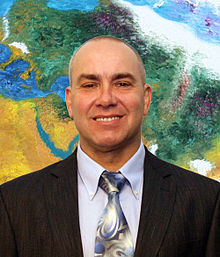Sergey Zagraevsky
| Sergey Zagraevsky | |
|---|---|

Zagraevsky in 2011
|
|
| Born |
August 20, 1964 Moscow, Russia |
| Nationality | Russia, Israel |
| Education | Private Studio of |
| Known for | Painting, art critic |
| Movement | Close to naïve art, primitivism |
| Awards | , Member of Russian Academy of Arts |
Sergey Zagraevsky (Russian: Сергей Вольфгангович Заграевский, Hebrew: סרגיי זגרייבסקי; born August 20, 1964, Moscow) is a Russian-Jewish painter,architectural historian, writer and theologian.
Zagraevsky is the son of architectural historian (1933–2004) and poet and dramatist (born 1933).
He began to paint at school and his first teacher was the well-known Russian painter .
Between 2002–2005 Zagraevsky taught at the Moscow Institute of Restoration Arts, and subsequently at the Russian University of Intellectual Property and in the Vladimir-Souzdal Museum. The main themes of his architectural history research are ancient Russian white-stone buildings, the early architecture of Moscow and architectural connections between ancient Russia and Romano-Gothic Europe. His doctoral thesis was "North-Eastern Russian architecture from the end of 13th – first third of the 14th century".
Zagraevsky is the chief editor of the reference work "United Art Rating" and the author of a number of books on philosophy, theology and the history of architecture. He has written a number of children's stories and many articles of art criticism. He is the founder and curator of "RusArch" – the electronic scientific library on History of Old Russian architecture.
In 1992 he became a PhD of technique, received his doctorate in architecture in 2004, then became a Professor in 2005. Zagraevsky is also a full member of (since 2001), the AICA (since 2004), and the (since 2001), a (since 2009), a member of (since 2013).
Speaks Russian, English, Hebrew, German, French, Esperanto.
Zagraevsky's art does not belong to the classic primitive or naïve schools, since neither the formal nor actual parameters of primitive art are met. Instead, his style is best described as "primitivism", a genre which includes the "primitive" paintings of many artists who had an academic apprenticeship and extensive experience in other styles such as Paul Gauguin, Mikhail Larionov, Pablo Picasso and Paul Klee. There are some differences in Zagraevsky's style; his landscape paintings are "childish" in using a reverse perspective, the absence of chiaroscuro and the relatively accurate portrayal of parts. Zagraevsky uses predominantly open colours giving his paintings brightness comparable to children's painting. His paintings contain neither humour or violence as this are not normally seen in the art of children.
...
Wikipedia
